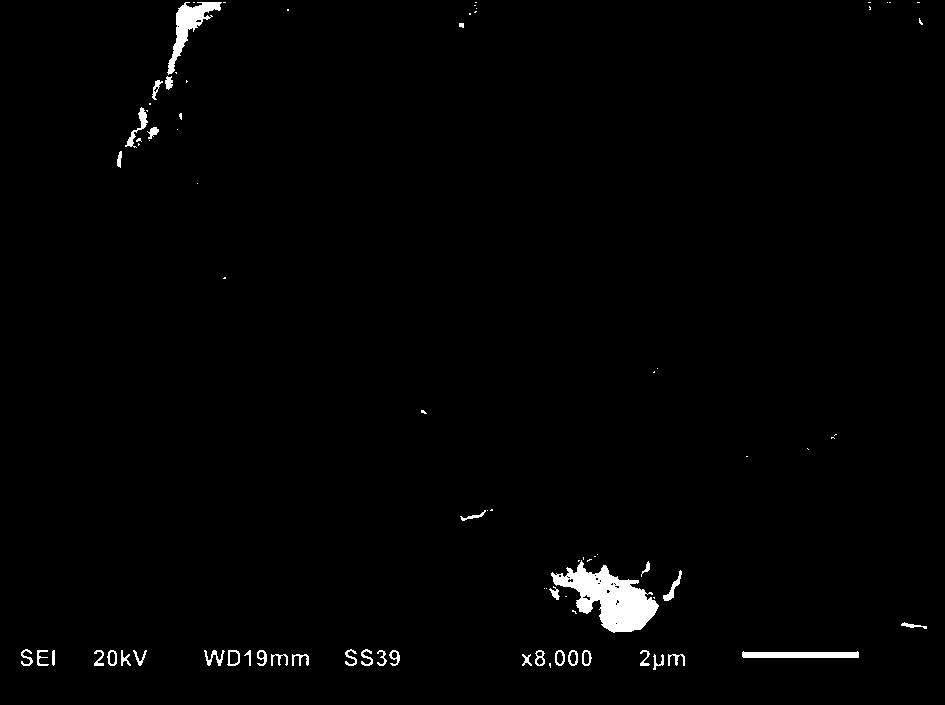Copper-aluminum-silicon alloy nanometer negative electrode material of lithium battery and preparation method of negative electrode material
A negative electrode material, silicon alloy technology, applied in battery electrodes, nanotechnology for materials and surface science, nanotechnology, etc., can solve poor cycle life and cycle efficiency, poor volume change cycle life, and small specific capacity development potential and other problems to achieve the effect of meeting coating requirements, reasonable particle size distribution, and unique microstructure
- Summary
- Abstract
- Description
- Claims
- Application Information
AI Technical Summary
Problems solved by technology
Method used
Image
Examples
Embodiment 1
[0036] Embodiment 1, a copper-aluminum-silicon alloy nano negative electrode material for a lithium battery, which is composed of the following raw materials in parts by weight: 27.5-32 parts of silicon, 58-63 parts of copper, 9-11 parts of aluminum, and 0-5 parts of impurities; The alloy nano-anode material as a whole includes: pores, shrinkage cavities, shrinkage porosity, dislocations, vacancies and cavities with a multi-defect organizational structure, and the particle size is ≤ 80 μm.
[0037] The present embodiment is prepared according to the following steps:
[0038] (1) Ingredients of Cu-Al-Si alloy:
[0039]Cut pure copper into φ50mm×100mm rods, pre-treat with pickling and vacuum drying before use, and control the drying temperature at 110±5°C; cut pure aluminum into 50mm×50mm×30mm small aluminum plates, and use acid before use Washing plus vacuum drying pretreatment, the drying temperature is controlled at 200±5°C; the block size of metal silicon is controlled at 5...
Embodiment 2
[0059] Embodiment 2: a copper-aluminum-silicon alloy nano negative electrode material for a lithium battery, consisting of the following raw materials in parts by weight: 27.5 parts of silicon, 58 parts of copper, 9 parts of aluminum, and 0.5 part of impurities; its preparation method is as follows:
[0060] (1) Ingredients of Cu-Al-Si alloy:
[0061] Cut pure copper into φ50mm×100mm rods, pre-treat with pickling and vacuum drying before use, and control the drying temperature at 110±5°C; cut pure aluminum into 50mm×50mm×30mm small aluminum plates, and use acid before use Washing plus vacuum drying pretreatment, the drying temperature is controlled at 200±5°C; the block size of metal silicon is controlled at 5-30mm, pickling before use to remove surface impurities, and then vacuum drying, the drying temperature is controlled at 180± 5°C. The total weight of the ingredients is 20Kg, 27.5 parts of silicon, 58 parts of copper, 9 parts of aluminum, and 0.5 parts of impurities (in...
Embodiment 3
[0074] Embodiment 3: a copper-aluminum-silicon alloy nano negative electrode material for a lithium battery, consisting of the following raw materials in parts by weight: 32 parts of silicon, 63 parts of copper, 11 parts of aluminum, and 5 parts of impurities; its preparation method is as follows:
[0075] (1) Ingredients of Cu-Al-Si alloy:
[0076]Cut pure copper into φ50mm×100mm rods, pre-treat with pickling and vacuum drying before use, and control the drying temperature at 110±5°C; cut pure aluminum into 50mm×50mm×30mm small aluminum plates, and use acid before use Washing plus vacuum drying pretreatment, the drying temperature is controlled at 200±5°C; the block size of metal silicon is controlled at 5-30mm, pickling before use to remove surface impurities, and then vacuum drying, the drying temperature is controlled at 180± 5°C. The total weight of ingredients is 20Kg, 32 parts of silicon, 63 parts of copper, 11 parts of aluminum, and 5 parts of impurities (including: t...
PUM
| Property | Measurement | Unit |
|---|---|---|
| Particle size | aaaaa | aaaaa |
| Particle size | aaaaa | aaaaa |
| Thickness | aaaaa | aaaaa |
Abstract
Description
Claims
Application Information
 Login to View More
Login to View More - R&D
- Intellectual Property
- Life Sciences
- Materials
- Tech Scout
- Unparalleled Data Quality
- Higher Quality Content
- 60% Fewer Hallucinations
Browse by: Latest US Patents, China's latest patents, Technical Efficacy Thesaurus, Application Domain, Technology Topic, Popular Technical Reports.
© 2025 PatSnap. All rights reserved.Legal|Privacy policy|Modern Slavery Act Transparency Statement|Sitemap|About US| Contact US: help@patsnap.com



